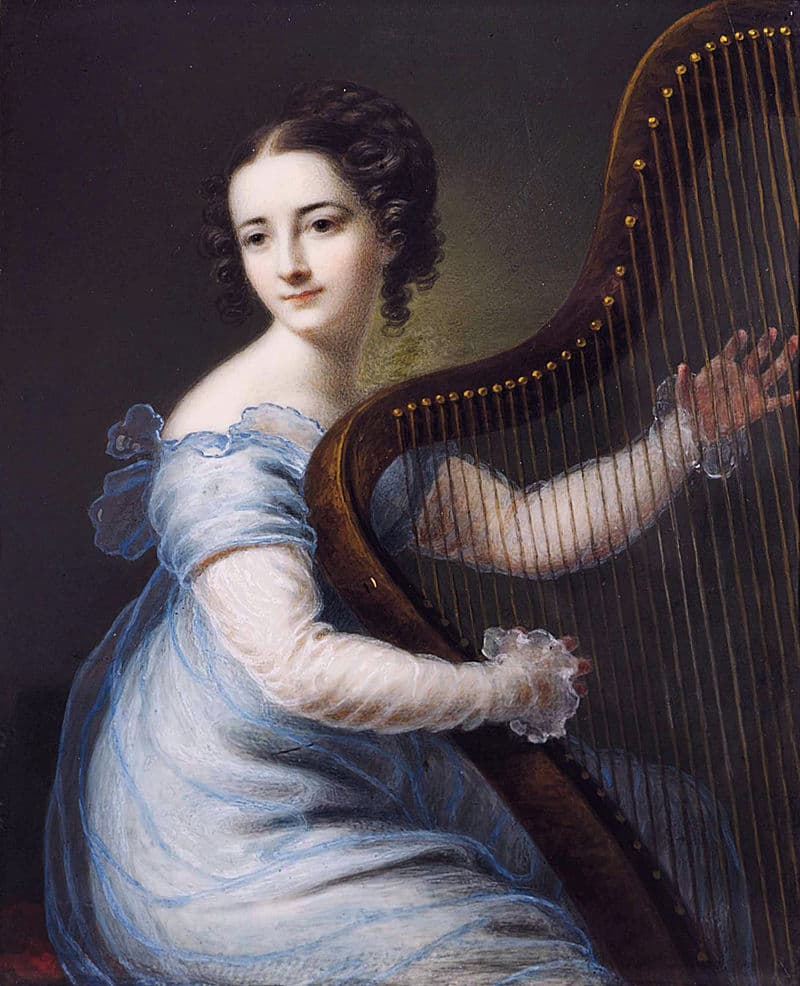We all have the image of the suffering and tormented artist in our minds. Constantly in money troubles and frequently neglecting personal hygiene, such artistic geniuses are all alone in a shallow world that does not understand nor appreciate them. This might certainly be true for a number of creative geniuses, but it does not apply to Louis Spohr (1784-1859). His contemporaries saw this upright character translated into physical terms as he was nearly 6 foot 7 inches tall, and there was no suffering at all! He loved to attend parties and was a gifted painter and enthusiastic rose-grower. A keen swimmer and hiker, Spohr played chess, billiards, dominoes and all matter of ball games. He loved to visit cultural attractions, art galleries, and churches, but he also toured factories, mines, and industrial installations. In short, he had a love of life and a thirst for knowledge about everything and everyone. And that included the brilliant harpist Dorothea Scheidler, whom he married in 1806.
Louis Spohr: Concertante for Violin and Harp, WoO 13 (Hansheinz Schneeberger, violin; Ursula Holliger, harp; English Chamber Orchestra; Peter-Lukas Graf, cond.)

Louis Spohr © violinist.com
Spohr was a performing violinist, and during an extended concert tour, he went to Vienna, met Haydn and Mozart, and was a guest in Beethoven’s house when he was working on his “Ghost Piano Trio.” In his youth, he had briefly taken harp lessons, but during his visit to the town of Gotha, he “ heard a young girl execute a difficult “Fantasia” with the greatest confidence, and with the finest shades of expression. I was so deeply moved,” he writes, “that I could scarcely restrain my tears. Bowing in silence, I took my leave, but my heart remained behind!” That young girl turned out to be Dorothea, or, as she preferred to be called, Dorette Scheidler. In due time, she would be remembered as the premiere harp virtuoso of the early nineteenth century. Spohr soon accompanied Dorette on the piano and violin, and he composed a concerted sonata for violin and harp, “which I practiced with her in the most careful manner.” One day, the ensemble was invited to a private concert, and they rode to the venue in a carriage together. “Thus alone for the first time with the beloved girl, I felt the impulse to make a full confession of my feelings towards her, but my courage failed me, and the carriage drew up before I had been able to utter a syllable. As I held out my hand to her to alight, I felt by the tremor of hers how great had also been her emotion.”
Louis Spohr: Sonata for Violin and Harp in G Major, Op. 115 (Cecilia Bernardini, violin; Masumi Nagasawa, harp)

Dorette Scheidler
That concert turned out to be a great success, and on the drive home, Spohr found enough courage to ask, “Shall we thus play together for life? Bursting into tears, she sank into my arms; the compact for life was sealed! I led her to her mother, who joined our hands and gave us her blessing.” The wedding date was fixed for 2 February 1806, and the marriage took place in the Palace Chapel. During their honeymoon, Spohr began to make a diligent study of the harp “in order to ascertain what was best adapted to the character of the instrument. Since my wife had already mastered the whole technique of the instrument, I gave free play to my fancy and soon succeeded in obtaining a wholly new effect from the instrument…The harp sounded most advantageously in combination with the singing tones of my Violin.” Inspired by his wife, Spohr composed a number of dedicated works, which the couple took on periodic concert tours, frequently lasting the better part of 6 months. The union produced three daughters, and according to her husband, “Dorette was the model of wifely devotion and artistic integrity.” She toured the courts and concert halls of Europe, playing his compositions and teaching music to the children of the aristocracy while also caring for her own growing family. The hardship of this double life eventually caught up with Dorette, and on 20 November 1834, “her malady assumed the form of a nervous fever, which carried her off, and to the present day I think with bitter sadness of the moment when I pressed the last kiss upon her forehead.”
For more of the best in classical music, sign up for our E-Newsletter
Louis Spohr: Trio for Violin, Cello and Harp in E minor (Sophie Langdon, violin; Susan Dorey, cello; Hugh Webb, harp)

